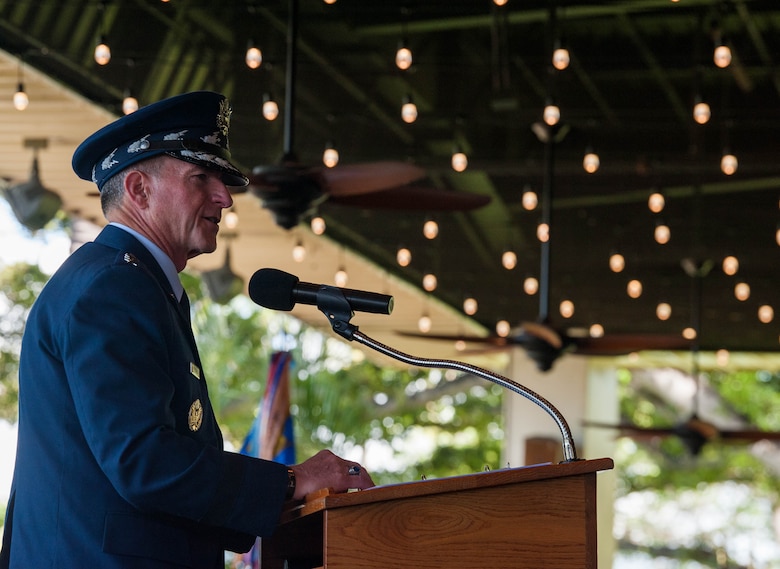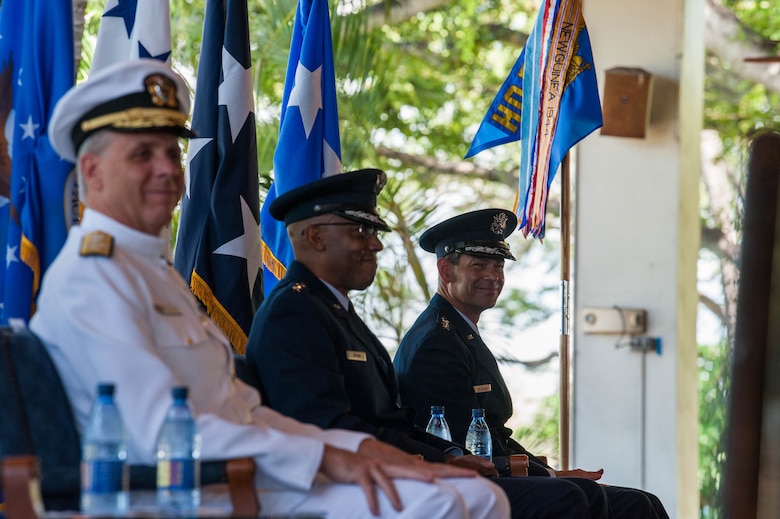Pacific Air Forces' Airmen welcomed Gen. Kenneth S. Wilsbach and bid farewell to Gen. CQ Brown Jr. as Pacific Air Forces' commander during a change of command ceremony held at Joint Base Pearl Harbor-Hickam and virtually across the region, July 8.
Presiding over the ceremony were U.S. Navy Adm. Philip Davidson, commander of U.S. Indo-Pacific Command, and Air Force Chief of Staff Gen. David L. Goldfein.
"Ken is no stranger to the Indo-Pacific (area of responsibility)," Goldfein said. "This will be his ninth assignment in the Pacific, having had multiple tours at Kadena Air Base, Japan; (JB) Elmendorf (-Richardson), Alaska; here in Hawaii and most recently at Osan Air Base, Korea, as the Seventh Air Force commander. He is laser-focused on joint warfighting excellence, ready today, to fight tonight. 'Cruiser' and Cindy (Wilsbach) epitomize the concept of a command team and do it with unparalleled class and style."
A change of command ceremony is a highly honored tradition amongst military personnel; all stops are pulled out and everything and everyone is put on display. Generally, there is a hangar bursting of Airmen from across the command, the stage is set with one of the biggest American flags one would possibly ever see with a backdrop of various aircraft such as the behemoth and most flexible cargo aircraft-the C-17 Globemaster III; or the compact, multi-role fighter-the F-16 Fighting Falcon.
No matter the aircraft, all eyes are on the stage-and with a simple, simulated "pass" of the guidon, a final salute, a first salute and the words, "Sir, I relinquish command," and, "Sir, I assume command," Wilsbach is now the commander of Pacific Air Forces.
Those words and the authority and responsibility conveyed in them have been said many times throughout history. Dating back to the Continental Army of the United States, the change of command ceremony has survived as an integral part of the Air Force heritage to this day.
As the 36th COMPACAF, Wilsbach now oversees approximately 46,000 Airmen, serving principally in Japan, South Korea, Hawaii, Alaska and Guam. PACAF's area of responsibility is home to 60% of the world's population in 36 nations spread across 53% of the Earth's surface and 16 time zones, with more than 1,000 spoken languages. The command oversees nine Air Force installations and three Numbered Air Forces.
In his speech, Wilsbach previewed a few of his priorities for PACAF, including readiness and resilience of the force, working with allies and partners, supporting Airmen and their families, and coordinating with other components in the theater.
"As has been stated, I've been fortunate to serve here about half of my career, and over that time the theater has certainly matured, it's changed dramatically, it's become a lot more complex, and it's become, frankly, the strategic epicenter for our nation," Wilsbach said. "And I am totally energized for the opportunity, and I'm very proud to lead the Airmen in the priority theater."
Prior to taking the command at PACAF, Wilsbach served as the Seventh Air Force commander and Deputy Commander of U.S. Forces Korea. Other assignments include commander of Alaskan Command, Alaskan North American Aerospace Defense Command Region, and Eleventh Air Force.
PACAF delivers agile air, space and cyberspace capabilities in support of U.S. Indo-Pacific Command's objectives, uniting allies and partners to enhance regional stability and security. For more than seven decades, PACAF has served in defense of the nation. The command continually prepares to bring air power quickly and decisively to the far reaches of the Pacific.
Even though Brown said goodbye to PACAF Airmen, it is more of a "a hui hou" or "see you later" as he is headed to Washington, D.C. to become the next Air Force chief of staff.
Davidson recapped the importance of Brown's tenure.
"His leadership over the past two years demonstrates his unique ability to innovate, to inspire, and to impress, and that includes his subordinates, his peers and his superiors alike," Davidson said. "CQ's leadership has led to the proliferation of fifth-generation fighter capability by PACAF, by the Royal Australian air force, and by the Republic of Korea air force, increasing our joint and combined force lethality and helping us deter aggression here in the Indo-Pacific."
While in command, Brown conducted 256 key leader engagements, visited 15 Indo-Pacific nations and hosted the largest Air Chiefs gathering in the history of PACAF.
"No different from the day I took the command, every day that I've been in command I've been extremely honored, blessed, and proud to serve as the 35th commander of Pacific Air Forces," Brown said. "I'm honored by the opportunity to lead PACAF. I'm honored by the trust and confidence afforded to me by both Adm. Davidson and Gen. Goldfein to lead in the Department of Defense's priority theater, the Indo-Pacific.
I'm proud of all that we've accomplished together at PACAF, but I know there's much more to be done," Brown continued. "Sharene and I are very honored to pass the PACAF leadership responsibilities to 'Cruiser' and Cindy Wilsbach."

Gen. Kenneth S. Wilsbach salutes Air Force Chief of Staff Gen. David L. Goldfein as he assumes command of Pacific Air Forces from Gen. CQ Brown Jr. during a change of command ceremony on Joint Base Pearl Harbor-Hickam, Hawaii, July 8, 2020. As the 36th COMPACAF, Wilsbach now oversees approximately 46,000 Airmen, serving principally in Japan, South Korea, Hawaii, Alaska and Guam. (U.S. Air Force photo by Staff Sgt. Hailey Haux)

Air Force Chief of Staff Gen. David L. Goldfein gives his remarks during a change of command ceremony on Joint Base Pearl Harbor-Hickam, Hawaii, July 8, 2020. During the ceremony, Gen. Kenneth S. Wilsbach assumed command of Pacific Air Forces from Gen. CQ Brown Jr. (U.S. Air Force photo by Staff Sgt. Hailey Haux)

Gen. Kenneth S. Wilsbach, Pacific Air Forces commander, gives remarks during a Change of Command Ceremony on Joint Base Pearl Harbor-Hickam, Hawaii, July 8, 2020. Wilsbach assumed command of PACAF from Gen. CQ Brown, Jr. during the ceremony. Prior to taking the command at PACAF, Wilsbach served as the Commander, 7th Air Force and Deputy Commander, U.S. Forces Korea. Other assignments included, Alaskan Region, North American Aerospace Defense Command, Commander, Alaskan Command, U.S. Northern Command and Commander, 11th Air Force. (U.S. Air Force photo by Staff Sgt. Hailey Haux)

U.S. Navy Adm. Philip Davidson, commander of U.S. Indo-Pacific Command, Gen. CQ Brown Jr. and Gen. Kenneth S. Wilsbach listen as Air Force Chief of Staff Gen. David L. Goldfein gives his remarks during the Pacific Air Forces' change of command ceremony on Joint Base Pearl Harbor-Hickam, Hawaii, July 8, 2020. PACAF's area of responsibility is home to 60% of the world's population in 36 nations spread across 53% of the Earth's surface and 16 time zones, with more than 1,000 spoken languages. (U.S. Air Force photo by Staff Sgt. Hailey Haux)






